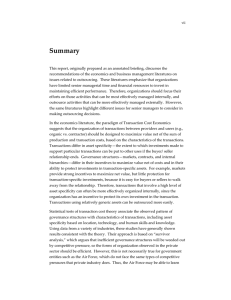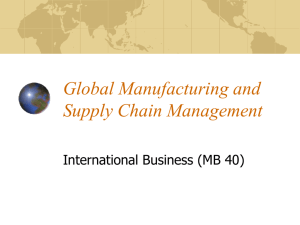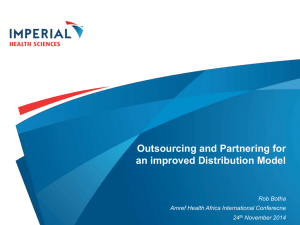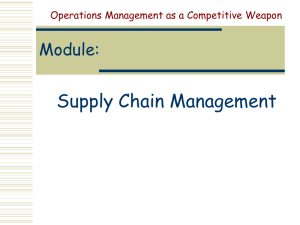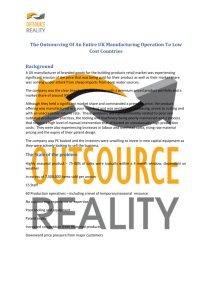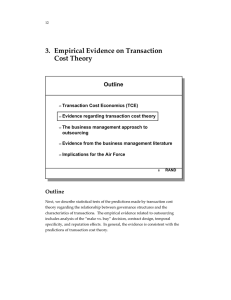6. Implications for the Air Force Outline
advertisement
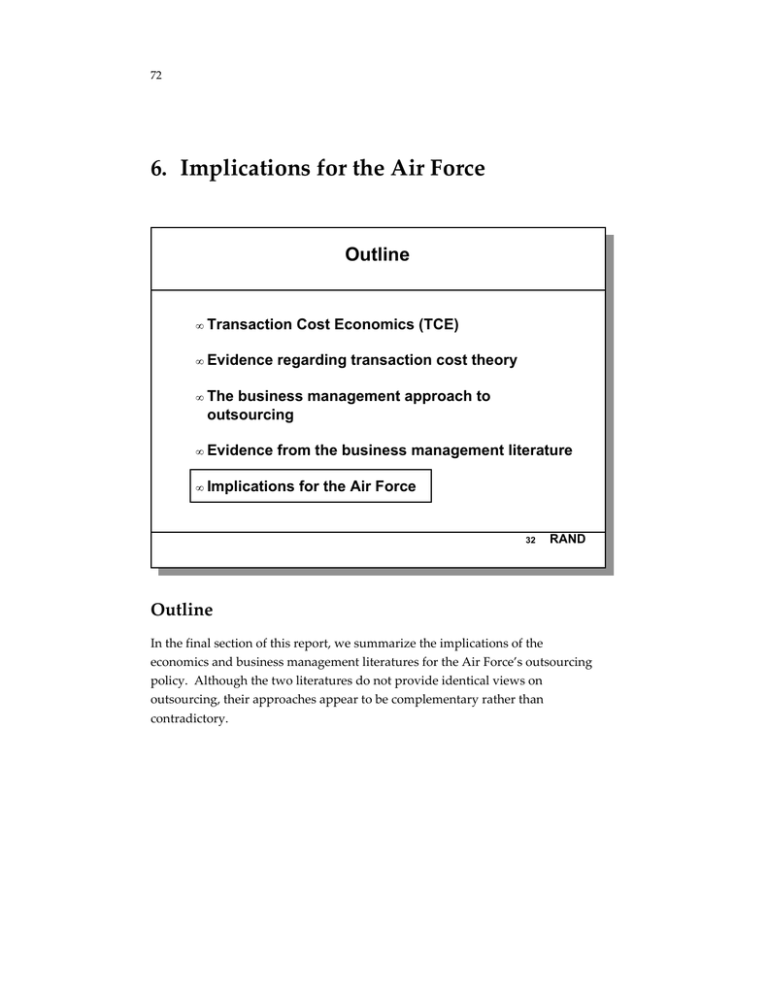
72 6. Implications for the Air Force Outline Outline • • • • • Transaction TransactionCost CostEconomics Economics(TCE) (TCE) • Evidence Evidenceregarding regardingtransaction transactioncost costtheory theory • The Thebusiness businessmanagement managementapproach approachtoto outsourcing outsourcing • Evidence Evidencefrom fromthe thebusiness businessmanagement managementliterature literature • Implications Implicationsfor forthe theAir AirForce Force • 32 32 RAND RAND Outline In the final section of this report, we summarize the implications of the economics and business management literatures for the Air Force’s outsourcing policy. Although the two literatures do not provide identical views on outsourcing, their approaches appear to be complementary rather than contradictory. 73 Core CoreCompetencies Competenciesand andAsset AssetSpecificity Specificity Influence InfluenceSourcing SourcingDecisions Decisions • The Thenumber numberofofactivities activitiesthat thatan anorganization organizationcan can manage effectively is limited manage effectively is limited • −−TCE TCEfocuses focuseson onasset assetspecificity specificity −−Management literature focuses Management literature focuseson oncore core competencies competencies • Both Bothconcepts conceptscan canbe beused usedby bythe theAir AirForce Force −−Identify core competencies Identify core competencies • −−IfIfnon-core non-coreactivities activitiesinvolve involvetransactiontransactionspecific investments, outsourcing specific investments, outsourcingisismore more difficult difficult 33 33 RAND RAND Core Competencies and Asset Specificity Influence Sourcing Decisions The two literatures agree that there is a limit to the number of activities that the senior management of a single organization can manage effectively. The transaction cost literature recommends that governance structures should be chosen to maximize value net of production and governance costs. Therefore, the activities that should be governed internally are those that involve transaction-specific investments, particularly in the presence of uncertainty and thin markets. The business management literature suggests that the limits on managerial time and resources should be handled by focusing on the organization’s “core competencies.” Core competencies are defined as activities that are central to the organization’s customers and mission, in which it has unique capabilities and can meet world-class performance standards. Both asset specificity and core competencies seem to be important concepts for the Air Force to consider in its outsourcing decisions. The Air Force needs to focus its resources to ensure that it is a world-class provider of its core competencies, and to use outsourcing to gain access to world-class performers of less central activities. If non-core activities require the use of transaction-specific 74 assets, the potential for opportunism may make contracting with outside providers difficult. Non-core activities using relatively generalized assets are likely to be the best candidates for outsourcing. However, the business management literature suggests that it may be feasible to outsource activities involving transaction-specific assets if the Air Force can develop long-term partnerships with its suppliers. 75 Good GoodSource SourceSelection Selectionand andContract ContractDesign Design Can CanImprove ImprovePerformance Performance • Sourcing Sourcingdecisions decisionsshould shouldnot notbe bebased basedsolely solelyon on direct costs; other factors include direct costs; other factors include • − Value of better performance − Value of better performance − Management and monitoring costs − Management and monitoring costs − Reputation of supplier − Reputation of supplier • Contracts Contractsshould shouldbe betailored tailoredtotomanage managethe thebuyerbuyerseller sellerrelationship relationship • − Defining measures of performance, conflict resolution − Defining measures of performance, conflict resolution procedures, and provisions for gain sharing can create a procedures, and provisions for gain sharing can create a solid framework for a long-term relationship solid framework for a long-term relationship − Long-term contracts, adjustment provisions, and − Long-term contracts, adjustment provisions, and GOCOs can reduce potential for opportunism GOCOs can reduce potential for opportunism 34 34 RAND RAND Good Source Selection and Contract Design Can Improve Performance The business management literature focuses more directly on the processes involved in outsourcing than does the transaction cost literature. It emphasizes that the primary goal of outsourcing should be getting better value for money rather than simply reducing direct costs. Outsourcing can also improve the organization’s strategic focus; create access to world-class capabilities, continuous improvement, and innovation through the supplier; accelerate reengineering; and allow the organization to share risks with external providers. Both literatures emphasize that the organization must consider management and monitoring costs as well as production costs in evaluating outsourcing options. The organization’s goals for outsourcing should be reflected in its source selection criteria, which should include the breadth and depth of the supplier’s experience; its financial solvency; its commitment to customer satisfaction, quality improvement, and technological innovation; and its reputation and willingness to offer performance guarantees. According to the business management literature, the outsourcing contract should serve as a framework for a long-term relationship between the buyer and 76 supplier. It is important to specify mutually agreed-upon measures of performance, informal conflict-resolution procedures, conditions under which the contract can be modified or terminated, and provisions for sharing gains from continuous improvement efforts or new technology. In addition, good communication links are essential to maintaining a long-term relationship and resolving problems before they become crises. Good source selection, contract design, performance monitoring, and communication can help mitigate the risks associated with the loss of direct control over an activity. The transaction cost literature also provides advice on contract design to address the problems of asset specificity and opportunism. When transaction-specific investments are not important, simpler fixed-price contracts will suffice. However, as assets become more specific to the transaction, the buyer needs to develop a more complex relationship with the supplier, based on a longer-term, more flexible contract. The degree of asset specificity and uncertainty should influence contract duration and price adjustment mechanisms. In some cases, buyer ownership of transaction-specific facilities (such as government-owned, contractor-operated [GOCO] facilities) or equipment can reduce the potential for opportunism while still allowing access to lower-cost, external providers. 77 Treat TreatSuppliers Suppliersof ofComplex ComplexServices Services as asPartners, Partners,Not notArm’s-Length Arm’s-LengthVendors Vendors • • • • Involve suppliers in the design of services Involve suppliers in the design of services • Work with suppliers to integrate processes and Work with suppliers to integrate processes and maximize maximizethe thevalue valuechain chain • Share Sharegains gainsofofcontinuous continuousprocess processimprovement improvement • Long-term partnerships can provide better Long-term partnerships can provide better performance performanceatatlower lowercost cost • −−Promote Promotetransaction-specific transaction-specificinvestments investments −−Preserve market incentives Preserve market incentives 35 35 RAND RAND Treat Suppliers of Complex Services as Partners, Not Arm’s-Length Vendors The business management literature on strategic alliances and buyer/supplier relationships suggests that long-term partnerships are more effective in improving performance and reducing costs than short-term attempts to squeeze supplier profit margins by frequent recompetitions that award contracts to the lowest bidder. Buyers should be open to suggestions from suppliers about how to design the service, integrate the activities of the buyer and supplier, and make continuous improvements to jointly related processes. To maintain supplier incentives for continuous improvement, the gains from better integration should be shared. Comparisons between U.S. and Japanese buyer/supplier relationships indicate that long-term partnerships can serve as a substitute for vertical integration by protecting investments in transaction-specific assets, while at the same time preserving market incentives to maximize value net of costs. Kelman [1990] argues that the traditional government procurement system has three goals: 78 • Equity—to provide fair access to bidders in competing for government business; • Integrity—to reduce the chances for corruption in the procurement process; and • Economy and efficiency—to procure goods or services of the quality desired at the lowest possible price. The traditional procurement culture adopted “full and open competition” as the best means of achieving these goals. However, the practices of developing rigid, detailed Requests for Proposals (RFPs) with minimal input from suppliers and excluding information on the supplier’s past performance have had detrimental effects on the quality of goods and services procured by the government. In particular, the government’s failure to use information on past performance encourages suppliers to make unrealistic promises in their proposals, and discourages incumbent suppliers from making transaction-specific investments in their relationship with the government. Recent efforts in acquisition reform have attempted to include greater information on past performance in the source selection process. For example, the Air Force’s Contractor Performance Assessment Report System (CPARS) requires annual assessments of contractor performance on current systems acquisitions greater than $5 million.1 This information can then be used by performance risk analysis groups (PRAGs) when assessing contractor risk or by source selection authorities when making source selection decisions. PRAGs are encouraged to use information outside of the offerors’ proposals to assess past performance, including CPARS, questionnaires or telephone interviews of contracting officers and program managers associated with similar contracts, and/or commercial references and data sources.2 Extending the use of CPARS and PRAGs to complex support services being considered for outsourcing should help the Air Force get better value from its contractors by rewarding good performance, developing longer-term relationships with good performers, and encouraging transaction-specific investments. As the defense industry consolidates, the Air Force has an added ________________ 1A systems contract is defined as a contractual effort for concept demonstration and validation, engineering and manufacturing development (EMD), production and deployment, modifications, or programmed depot maintenance. Replenishment spare parts contracts, base operating support contracts, and service contracts for operation and maintenance efforts are not included. See AFMC, Instruction 64-107, CPARS, 1996. 2PRAGs can be appointed by source selection authorities to assess potential contractors’ performance risk. They assign ratings of high, moderate, or low risk, or a neutral rating if the contractor has no significant performance record. See Joint Aeronautical Commander’s Group (JACG), Performance Risk Assessment Group (PRAG) Desk Guide, Version 1.3, 1996. 79 incentive to develop partnerships with remaining firms, since it becomes more difficult to conduct full and open competition as the number of potential suppliers shrinks. However, it may not be as easy for the Air Force to develop long-term relationships with suppliers as it is for commercial firms. The procurement culture tends to discourage change and risk-taking on the part of contracting officers, who fear that source selection decisions may be challenged in the courts if they are based on subjective information about past performance. The government must overcome its history of mistrust and exit relationships, and suppliers must be convinced of the government’s commitment to long-term relationships. The traditional emphasis on full and open competition is also difficult to reconcile with the longer-term relationships and negotiated procurements sometimes used in the private sector.
